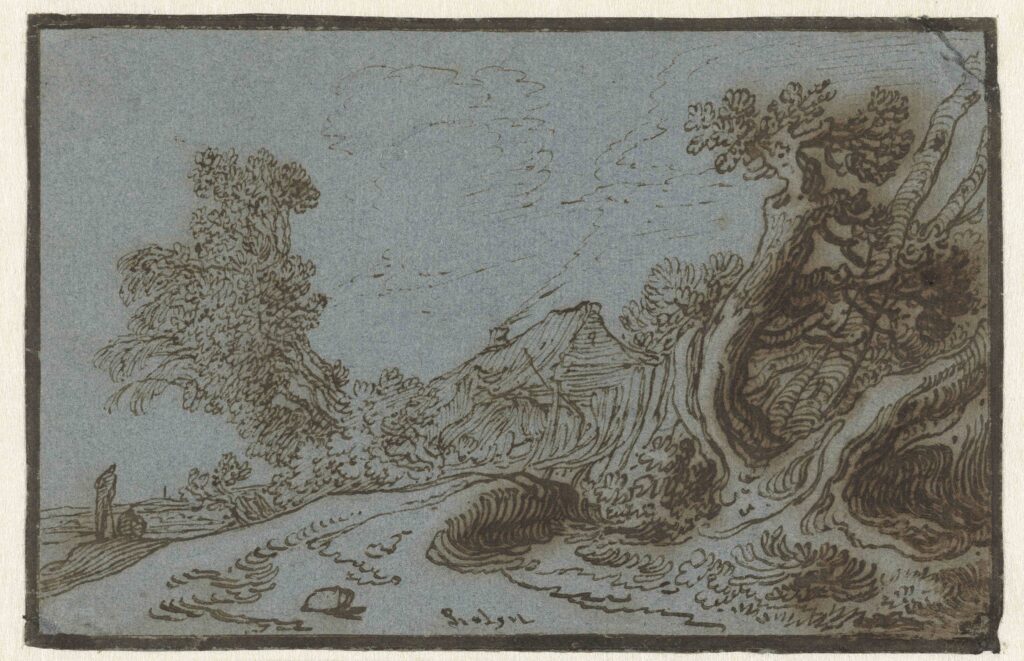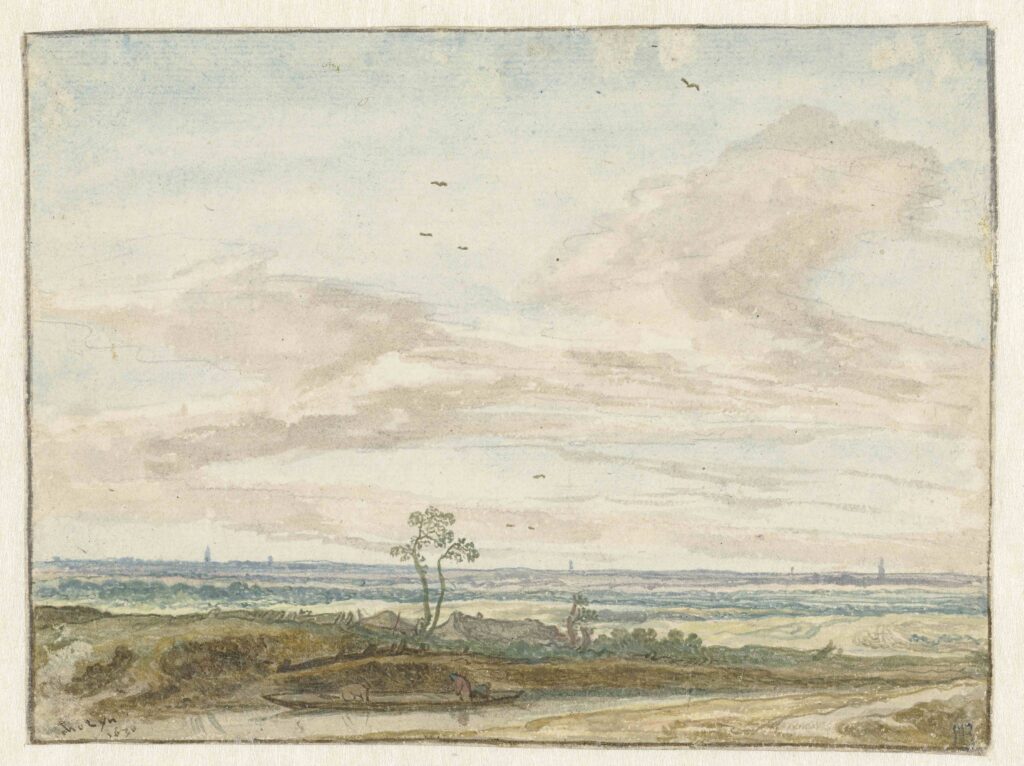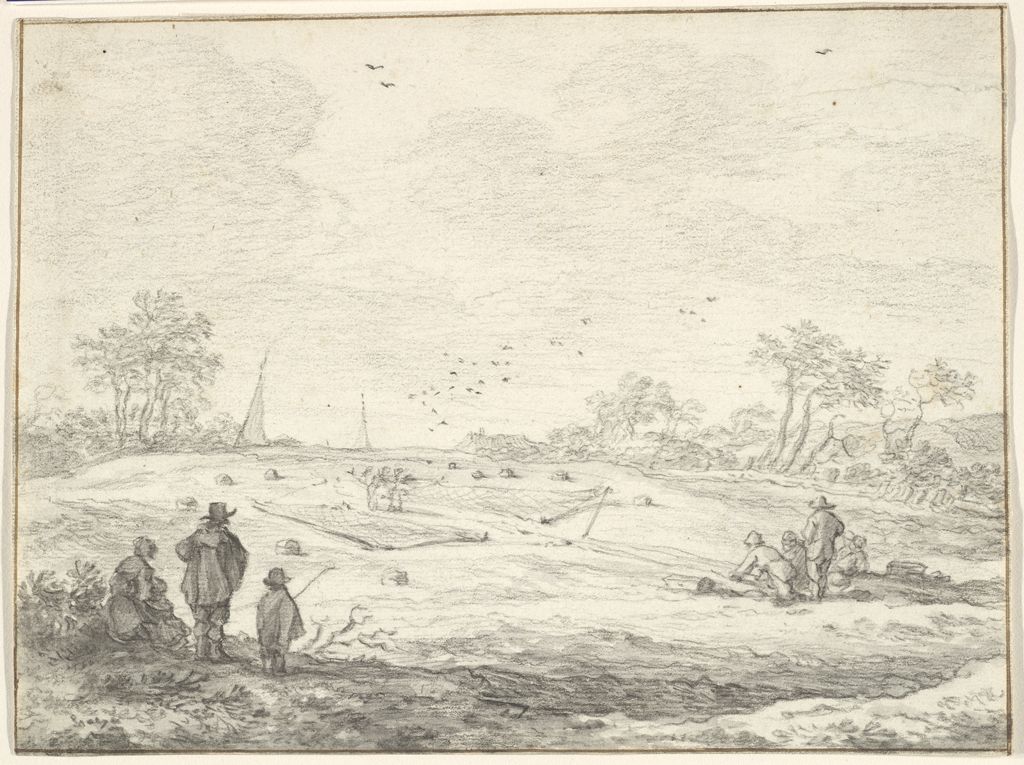Drawing from Life
Pieter de Molijn (6 April 1595-23 March 1661) was one of those incredibly prolific, yet highly enigmatic artists of the Dutch Golden Age. Little has been written, in regards to research on his biography and oeuvre.1 Born in London to a Flemish father and mother–from Ghent and Brussels, respectively–De Molijn emigrated to Haarlem early in life, joining the Guild of St. Luke in 1616.2 He is thought to have lived in Delft from 1616 to 1627, before returning to Haarlem, where he would remain until his death.3 No archival evidence exists to support any extensive travel during his lifetime–for instance to Rome, or Scandinavia–even as art historians have hypothesized the opposite.4 De Molijn is thus able to be pronounced as an artist active in Haarlem for most of his adult life, during the seventeenth century’s first half. That period of Haarlem’s history, is one in which its plethora of artists underwent a period of paradigm-shifting innovation in the compositions of landscape paintings and drawings. They merged the imaginative, and fantastical pictorial tendencies of mannerist artists active in the late-sixteenth century–as Hendrick Goltzius (1558-1611) and Karel van Mander (1548-1606)–with a raw, true to life approach toward the rendering of landscapes.

This early period of Haarlem’s landscape history is termed ‘early-realism’; their perspectives tend to be bird’s-eye-view in nature, employing the same pictorial devices as, for instance, those used by Peter Brueghel the Elder (1525-1569) and Hans Bol (1534-1593).5 The next phase in the city’s landscape evolution is ‘tonalism’, referring to the horizontal bandings of alternating contrasting colors, usually in a ‘wedge’ or thin triangular form, which artists used to mimic the dramatic strips of light that–still today–blanket Dutch polder and dune landscapes, when piercing through clouds.6 As the art historian Walter Gibson has noted: ‘These artists favored broad expanses of water and sky and diffuse, atmospheric tonalities achieved by a limited, at times almost monochromatic, palette and rapid brushwork.’7 After ‘tonalism’ was the so-called ‘classical’ phase of Haarlem’s landscape artists; its artists elevated the importance of elements of the Dutch landscape–often by using singular elements of nature, as a tree or river, as a compositional anchoring point. De Molijn was heavily influenced by the ‘early realists’, most prolific during the ‘tonalism’ phase, and would achieve a mastery of his landscapes–in drawing and paint–during the ‘classical’. Given De Molijn’s work spans all three eras, his oeuvre accurately reflects that progression of Haarlem landscape artists. As most of his many drawings render the Haarlem countryside, they are the focus of this study.
Given that about 500 of De Molijn’s drawings have survived the test of time, it is abruptly startling just how little research has been conducted toward them. In retrospect, De Molijn could also be considered a versatile artist; his drawn oeuvre also consists of cavalry scenes, several genre scenes, night (fig. 1), and even winter landscapes.8 Though, he is certainly best known for, and excelled at, rendering the dune landscapes that surrounded Haarlem (fig. 2); such as cottages in empty fields, views across land and bodies of water (fig. 3), from one bank to another, and scenes of several travelers wandering through paths in the dunes (fig. 4). Later in his life, De Molijn’s landscapes become weighted with dense vegetation, engulfing the few figures that populate his drawings–nearly always seen from behind. Beyond his figural silhouettes, rendering faces was De Molijn’s weakness; no portraits are traceable to him, drawn or painted. His painted oeuvre consists of a similar array of genres–again emphasizing the dunes outside of Haarlem–though in paint, he also portrayed the occasional kitchen scene, and Italianate architectural fantasy.

De Molijn was the master of several esteemed Dutch Golden Age artists, such as the Haarlem-based artist Jan van Goyen (1596-1656)–whose work is much more celebrated, and canonized.9 Several pupils are recorded as having been trained by De Molijn, with the most notable being Allaert van Everdingen (1621-1675), beginning in 1645, and Gerard ter Borch (1617-1681), in 1634.10 De Molijn had a son, Anthony de Molijn (1635-c. 1703), born in Haarlem, who was also an artist–and more than likely trained by his father. The son’s work is extremely rare in nature, and incredibly similar to his father’s.11 De Molijn is also thought to have trained Gerard ter Borch the Edler (1583-1682), as well as the Haarlem-based landscapist, Jan Wils (1603-1666), who remains understudied.12 The late art historian Egbert Haverkamp-Begemann, has observed a dependency of De Molijn on Hercules Segers (1589-1638) for several of his compositions–in that one figure is in the middle ground, with a second figure silhouetted against the horizon.13
500 De Molijn Drawings: The Current State of Research
Two major studies of De Molijn currently exist. One is a PhD dissertation completed in 1988, by Eva Jeny Allen, at the University of Maryland, under the guidance of Dr. Arthur Wheelock Jr. (former ‘Curator of Northern Baroque Paintings’ at the National Gallery of Art, in Washington D.C.). Allen’s study, The Life and Art of Pieter Molyn, dates from the 1980s; it has also applied formalism as its main methodology, stringing together known dates and major works. She carefully divides De Molijn’s biography and art, into three distinct phases–1625-1632, 1633-1647, and 1648-1661–which roughly mirrors the last two phases of innovation, in Haarlem’s representation of landscape in art. The Haarlem-based artists who were most associated with advancing the portrayal of landscapes, from the ‘early realist’ phase to that of ‘tonalism’, are considered to be: Jan van Goyen, Esaias van de Velde, Williem Buytewech (15920-1624), and Salomon van Ruysdael (1602-1670).14 Gibson has rightly observed and suggested that nearly all these artists were not born in the city, and departed for Amsterdam during the 1620s. De Molijn also then departed, for Delft, but unlike the others he would return and remain in Haarlem for the rest of his life, continuing to influence his peers.

Simultaneously, there exists a catalogue raisonné of De Molijn’s drawings, published in 1998 by the late Dr. Hans Ulrich-Beck (1930-2010); a doctor by trade who just so happened to harbor a profound interest in the work of Jan van Goyen, and his ‘circle’. The catalogue is entitled Pieter de Molyn, 1595-1661: Katalog der Handzeichnungen, and is the only publication devoted to his drawings. It begins with a brief overview of his life–which is highly dependent on Allen’s 1988 study–outlining a concise biography while defining his drawing by classification types, such as: night and winter scenes, cavalry, mountainous scenes, ‘unruly weather, as well as ‘catching birds with nets’.15 ;The publication includes all known drawings–about 500–with only a very basic, sentence-long description for each. The catalogue does, however, include a very useful list of earlier literature; though all of which mention De Molijn in passing, rather than as the main subject.16 Beck has simplistically categorized De Molijn’s drawings: those before 1640, and those from 1641-1661.17 In 1946, it was remarked that De Molijn may have possibly traveled to Italy and Switzerland–though still no evidence had been unturned to support that by 1998, in Beck’s catalogue of drawings.18 Beck often compares De Molijn’s work to Van Goyen’s, as he was a Van Goyen expert. But their main difference regarding drawings, is Van Goyen creates compositions through successive horizontal layering, whereas De Molijn makes strict use of diagonals (using the contours of trees, houses, and staffage aligning ‘just so’, to do so), which leads and recedes one’s eye into the image.19 It was thus De Molijn, not Van Goyen, who was the master ‘tonalist’.
Most of De Molijn’s drawings on blue paper date from the early, first phase of his career, as do his images of soldiers, most of which serve as figural studies. As his career progressed, his imagery of the Dutch countryside and dunes tend to comprise the bulk of his drawn output. His 1620s ‘tonalism’ technique, of contrasting bands, progressed in the 1630s toward a more nuanced, and less harsh variation of light and shade, combined with changes in elevation–as opposed to his earlier renderings of a flat countryside. As has been accurately observed of his work, ‘His foregrounds are usually in shadow, full light falling in the middle distance.’20 De Molijn’s work from the late-1630s and 1640s has less of an emphasis on bands of contrasting color, though begins to use compositional anchoring points–consisting of clumps of trees, and swirls of thick, mangled vegetation. They are often adjacent to a dilapidated cottage, as well as counterbalanced with imaginary mountainous landscapes, through which paths meander. Versatile in medium; most of De Molijn’s drawings were made with black chalk, or ink. Just as the few colored drawings he produced are rare–so too are his works on blue paper.21
Future Directions: An Artist Absent a Catalogue Raisonné
While drawings are integral to understanding the development of De Molijn’s draftsman skills throughout the course of his career–much less attention has been paid to his paintings. To truly progress existing research, there must be a rigorous investigation of his drawings and paintings. Once this work is complete, only then can correlations between his drawings and paintings occur–identifying drawings made after paintings, and drawings used as preparatory studies for paintings. Allen’s 1988 study admittedly lacked any attempt at a catalogue raisonné, perhaps precisely because, before her, there did not even exist a complete study of his life.22 Yet, given that Allen scoured through archival documents in support of her study, she did so during the 1980s; before widely publicly accessible search engines, of collections and archives, on the internet.23 There is undoubtedly more information to be uncovered, to complete details of De Molijn’s biography that she may have missed. For instance, what exactly was De Molijn doing during his supposed years-long stay in Delft? Which works did he make there, and how did his time there affect the evolution of his own style–and subsequently influence his peers, in Haarlem? One aspect of De Molijn’s drawings that Beck has rather convincingly laid out, is the production of duplicate drawings; he counts at least 25.24 There is evidence that De Molijn made drawings after his paintings, and vice versa; future research could explore that process.

Combining paintings and drawings of De Molijn in a catalogue would be useful, and certainly progress existing research on other Haarlem artists; though, the task is daunting–and probably suitable as a PhD project, or another similarly funded venture. Such a study seems unlikely to be carried out, for instance, by the Frans Hals Museum, given the little popularity in the Dutch art history field attached to Pieter de Molijn and his oeuvre. Beck had commented in his 1998 catalogue that no research has been done on the provenance of De Molijn drawings–his works owned by the Rijksmuseum, are perhaps the most complete in this respect, as is evidenced in their 1979 catalogue.25 Beck further notes that there exist no studies concerning reception of De Molijn’s work; this is certainly due to the lack of any solo exhibition devoted to his work.26 Perhaps a reason De Molijn hasn’t been the subject of his own exhibition, or had a catalogue raisonné of drawings and paintings produced on his work; is that his innovativeness is much less immediate–formally evident–than that of other Dutch Golden Age artists. Perhaps this is precisely due to the nature of his ‘simple, unpretentious scenes,’ most of which tend to only render fields, cottages, and dunes.20 His work, and more specifically his many drawings, seem destined to remain overlooked throughout the near future. De Molijn’s innovativeness lies not in chiaroscuro, nor in introducing classicism to Haarlem; instead, his diagonal compositions and contrasting ‘wedges’, to create a sense of pictorial depth–are subdued, quiet, and serene. For these reasons, his work doesn’t scream out for attention, and is best understood through the use of words–which makes his work even less prone to being exhibited. De Molijn is thus a bridge, linking the sixteenth-century Haarlem-based ‘early realists’, as Hendrick Goltzius and Esaias van de Velde with their ‘classicist’ later admirers, as Meindert Hobbema (1638-1709) and Jacob van Ruisdael (1628/9-1682); who continued to progress the many innovative techniques of representing the Dutch landscape–painted and drawn–as spearheaded by Pieter de Molijn.
- Shortly after finishing this essay in the spring of 2017, the following essay was published in the summer 2017 edition of the Journal for Historians of Netherlandish Art, which looks at the work of the artist on the art market during his own lifetime, and in doing so, reveals that Molijn’s work was more valuable than that of Jan van Goyen (1596-1656)—thus rectifying a historical misperception that has been in place throughout the twentieth and early-twenty-first century: Marion Boers, ‘Pieter de Molijn (1597–1661): A Dutch Painter and the Art Market in the Seventeenth Century’ Journal of Historians of Netherlandish Art 9:2 (Summer 2017) DOI: 10.5092/jhna.2017.9.2.5 It is an excellent addition to the literature on the artist by a historian who is specialized in Haarlem’s art market during the first half of the seventeenth century.↑
- Christopher D. M. Atkins, The Signature Style of Frans Hals: Painting, Subjectivity, and the Early Modern Market (Amsterdam: Amsterdam University Press, 2012), 143.↑
- Eva Jeney Allen, The Life and Art of Pieter Molyn (Ann Arbor: University of Michigan, 1988), 66.↑
- The late American art historian Seymour Slive (1920-2014) postulated De Molijn was familiar with Nordic landscapes, as per a trip to Scandinavia. He further hypothesized several collaborations with Frans Hals (1582/3-1666), within his family portraits, based off the presence of pine trees in the drawing Landscape with Pine Trees, at Staatliche Graphische Sammlungen, in Munich–which correspond to those in Hals’ 1626 Portrait of Issac Abraham Massa. Seymour Slive (ed.), Frans Hals (Maarssen: Gary Schwartz, 1989), 190-192, 272, 318. Slive’s theory of a De Molijn-Hals collaboration is De Molijn’s biggest ‘claim to fame’. Cornelis Hofstede de Groot (1863-1930) has suggested that De Molijn took an Italian trip in 1618. Eva Jeney Allen, The Life and Art of Pieter Molyn (Ann Arbor: University of Michigan, 1988), 38. No evidence supports that claim.↑
- Peter Sutton, Masters of Seventeenth–Century Dutch Landscape Painting (Boston: Museum of Fine Arts, 1987), 20-25.↑
- Ibid., 34-39.↑
- Walter S. Gibson, Pleasant Places: The Rustic Landscape from Bruegel to Ruisdael (Oakland: University of California Press, 2000), 25.↑
- Jef Schaeps and Jaap van der Veen (eds.), Leiden Viert Feest! (Leiden: Leiden University Press, 2014), 117↑
- Eva Jeney Allen, The Life and Art of Pieter Molyn (Ann Arbor: University of Michigan, 1988), 224. See also, note 1.↑
- Irene de Groot, Landschappen-Etsen van de Nederlandse Meesters uit de Zeventiende Eeuw (Maarssen: Gary Schwartz, 1979), 113. Eva Jeney Allen, The Life and Art of Pieter Molyn (Ann Arbor: University of Michigan, 1988), 38.↑
- Eva Jeney Allen, The Life and Art of Pieter Molyn (Ann Arbor: University of Michigan, 1988), 33-34.↑
- Ibid., 66.↑
- Egbert Haverkamp-Begemann, Hercules Segers: The Complete Etchings (Amsterdam/The Hague: Scheltema & Holkema, 1973), 54.↑
- Walter S. Gibson, Pleasant Places: The Rustic Landscape from Bruegel to Ruisdael (Oakland: University of California Press, 2000), 149.↑
- Hans-Ulrich Beck, Pieter Molyn, 1595-1661: Katalog der Handzeichnungen (Dornspijk: Davaco, 1998), 25. This is a rather surprising name with which to categorize a type of drawing by De Molijn, and is certainly unexpected, due to the scarcity of the genre, as it’s rendered by other Haarlem-based seventeenth-century artists. Nevertheless, De Molijn produced about 15 of these drawings. ‘Es gibt mindestens fünfzehn Zeichnungen Pieter Molyns, in denen er den Vogelfanbg mit Netzen auf einer Wiese;oder in den Dünen als haupt- oder Nebenthema darstellt.’; ‘There are at least 15 drawings by Pieter de Molijn, which having catching birds with nets in a field or in the dunes as their main theme.’↑
- Ibid., 33-35.↑
- Ibid., 25.↑
- Agnes Mongan and Paul J. Sachs, Drawings in the Fogg Museum of Art (Cambridge: Harvard University Press, 1946), 272.↑
- Eckhard Schaar, ‘Review of Pieter Molyn, 1595-1661: Katalog der Handzeichnungen by Hans-Ulrich Beck’ Master Drawings 39, no. 1 (Spring 2001): 61-62.↑
- Agnes Mongan and Paul J. Sachs, Drawings in the Fogg Museum of Art (Cambridge: Harvard University Press, 1946), 272.↑↑
- Marijn Schapelhouman and Peter Schatborn, Dutch Drawings of the Seventeenth Century in the Rijksmuseum, Amsterdam: Artists Born Between 1580-1600 (Amsterdam: Rijksmuseum, 1998), 48.↑
- Eva Jeney Allen, The Life and Art of Pieter Molyn (Ann Arbor: University of Michigan, 1988), 1.↑
- Judith Noorman, ‘Drawn into the Light: The State of Research in Seventeenth-Century Dutch Drawings’, in The Ashgate Research Companion to Dutch Art of the Seventeenth-Century, (ed.) Wayne Frantis (London: Routledge, 2016), 321, 332.↑
- Hans-Ulrich Beck, ‘Pieter de Molijn and His Duplicate Drawings’, Master Drawings 35, no. 4 (Winter 1997): 341-366.↑
- Irene de Groot, Landschappen-Etsen van de Nederlandse Meesters uit de Zeventiende Eeuw (Maarssen: Gary Schwartz, 1979), 110-117.↑
- Hans-Ulrich Beck, Pieter Molyn, 1595-1661: Katalog der Handzeichnungen (Dornspijk: Davaco, 1998), 31.↑